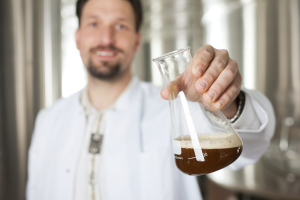Understanding the genes of yeast is big business. Yeast was one of the first DNAs to be sequenced and mapped, one of workhorse strains that is used in winemaking, baking, and brewing since ancient times. Since those times, new strains have been discovered and created, each one capable of making different kinds of beer, wine, spirits, and bread. By mapping out brewer’s yeasts in particular, scientists hope to understand why one yeast produces a pale ale and another one an amber.
The Mother of All Alcohol
Often the least talked about and the most overlooked, yeast is the one crucial ingredient in all forms of alcohol. In the fermentation process yeast breaks down the grain, fruit, or other vegetables, their consumption of this fuel creating both ethyl alcohol and carbon dioxide (along with exotic alcohol molecules which add much of the body and flavor, especially in distilled liquor). After this process the mash and yeast is strained or distilled out, though many beers and a few wines keep yeast in by design.
Mapping the Path
Now scientists are mapping out over 240 strains of beer brewing yeast (and including several wine and baker’s yeast for good measure) in hopes of learning what the difference in the yeast that makes Miller beer is compared to one that makes an IPA. Even more importantly, if scientists and brewers can map out the sequences of all these brewing yeasts, it could help them figure out how to cross-breed the yeasts to bring the characteristics of several beers together.
Sequencing for the Next Generation of Beer
While we have been creating new kinds of methods, ingredients, and brewer’s yeast for making beer for centuries, the creation of new kinds of brewing yeast has been serious trial and error. While two different yeasts might both produce excellent beers, crossing them together can often produce horrible results. Without knowledge of how the various parts of the yeast are made up and interact with each other, combining two brewers’ yeast is like blindly mashing together the parts of two different cars: the results are as often non-functional as they are unappealing.
Being able to map the sequences of each yeast and then comparing them will help brewers make informed decisions on cross-breeding, as well as understanding how different yeasts affect the same ingredients differently. While you can take four kinds of yeast and apply them to the same ingredients to create four very different beers in terms of both appearance and flavor, the reason behind why is poorly understood.
With this new information brewers can compare their yeast strains to their completion as well as unlocking the mystery of how the various genetic parts of the yeast relate to how beer tastes. Soon we might have a better understanding of how many of the products that use yeast are affect by the various strains we use, from bread to wine to hard alcohol.
This science lesson was brought to you today by Clean Beer, specializing in beer line systems and cleaning. If you’re interested in talking shop about the science behind beer, or the effect of yeast on lines and taps, please give Clean Beer a call.

Leave a Reply